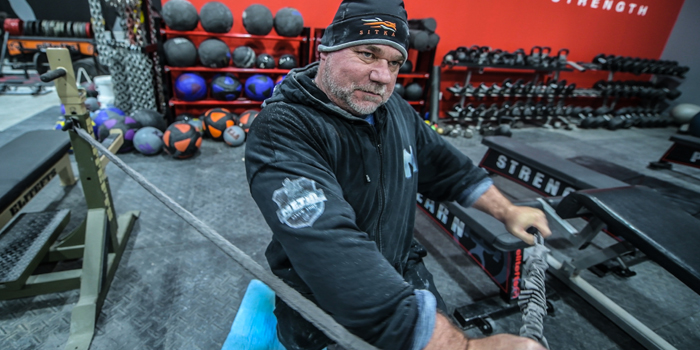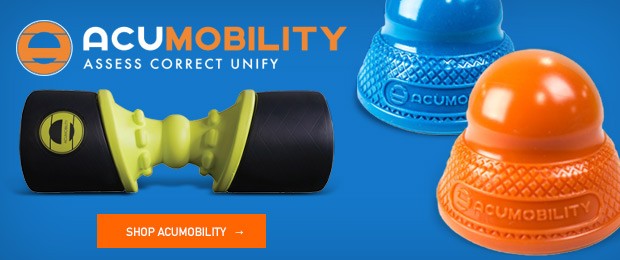
Editor's Note: Fixing Dave Tate is an educational video series intended for demonstration purposes only (acts as a case study specific to Dave Tate). It is not intended to medically diagnose, treat, or manage symptoms. If you are in pain, please consult a licensed healthcare professional.
It has been 10 weeks since the initial steps of the Fixing Dave Tate series. Since the previous videos, Dave has undergone two phases of training and has put Dr. Rusin's recommended alterations into place. Now it's time to get an update and reassess. This video shows the full 10-week update discussion between Dave and Dr. Rusin, including a free-flowing conversation about the project and an assessment of how Dave's feeling at this stage.
Dave begins by talking about the non-training factors that have influenced his progress since the first visit, namely his responsibilities as a father and business owner that have added complications to his training cycle. In the beginning of March, the Arnold Sports Festival hit. Though elitefts doesn't have a booth at the expo, there's always a lot going on for the company with team members in town competing and visiting the compound. That same weekend was parent's weekend for his son's school, so Dave's training had to be adjusted and the weekend training was not performed. Then the week of March 12 was Dave's other son's spring break trip to Florida, so no training was performed during that week. Then on the 19th Dave realized he had to go out of town again, this time for a supplier visit. More time away and more training sessions missed. Then when he made it back to Ohio that weekend, it was the elitefts Sports Performance Summit, which again kept him from his normal training schedule.
All of these responsibilities resulted in a very haphazard month of Dave struggling to get in all of his training, and led to a decrease in Dave's conditioning. During this time there should have been 28 training sessions—14 to 16 being serious lifts—but Dave performed only 50% of them. In response to this dilemma, Dr. Rusin points out that living a high-performance life is challenging and that, with someone like Dave, it's very easy to fall into the mindset that if you can't train 100% how you want to train, you won't train at all. If it's not fully your way, you don't do any of it. A shift in mindset about what is and isn't important can be incredibly helpful with this. If the right mindset shift occurs, restoration becomes the key factor of training; the non-negotiable aspect of training isn't the heavy lifting but is instead the secondary work that is designed to restore neurocapabilities and outlooks. Even if you're working a 24-hour day, a commitment of 10 to 20 minutes of these things will pay huge dividends.
WATCH: Fixing Dave Tate — The Dynamic Warm-Up Sequences for Upper Body and Lower Body
Dave and Dr. Rusin continue to discuss Dave's starting point and how it took several training cycles just to get to a stable level of competency. Before starting this project with Dr. Rusin, Dave was struggling with a number of things. Dave says that in recent years he has very rarely had more than a few weeks of consecutive good training, and he has been so deconditioned at points that even walking up a flight of stairs was unpleasant. Dave says that he truly started at "shit" and has just been working to get to "suck."
On this topic, Dr. Rusin explains the concept of minimum viable dose: what is the lowest level of each fitness quality needed so that you're able to perform your chosen activity? Your endurance capacity won't always need to be 10, and for a powerlifter it probably never will be, but if it reaches zero you're in trouble. Dr. Rusin says that there are four key variables you need to keep at a reasonable base level: strength, body composition, mobility, and endurance. This project is designed to help with each of these four components, and through the first phases, Dr. Rusin says he has witnessed three key indicators of Dave's improvements in these areas:
- Dave's ability to speak 30 seconds after performing a 13-rep, all-out, maximum rep set
- Dave's ability to easily get down on the floor and up from the floor before and after a floor press set
- Dave's ability to stabilize his hips in his box squat
In addition to these indicators, Dr. Rusin and Dave dig deeper into the successes and failures of the last 10 weeks. For the remainder of the conversation, Dave and Dr. Rusin discuss how they're using video to monitor progress, Dave's lightbulb moment with glute extensions and planks, controlled dynamic stability, Dave's nutritional protocol and weight changes, a scientific approach to variable manipulation, Dave's reduction in daily experience of pain, and Dave's confidence in this process.
FIXING DAVE TATE SERIES
- Initial Assessment with Dr. John Rusin
- Movement Screening
- Orthopedic Evaluation
- The Three Areas of Focus Discovered During Initial Evaluation
- Observing Dave's Current Training Capabilities
- Programming the Six-Phase Dynamic Warm-up Sequence









